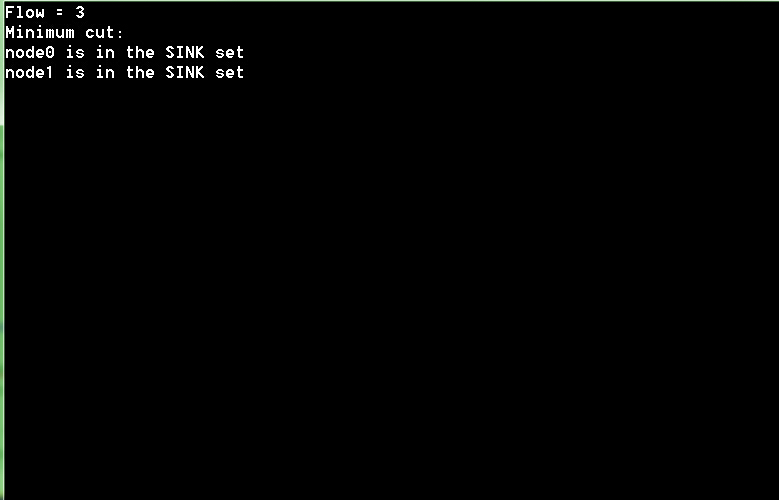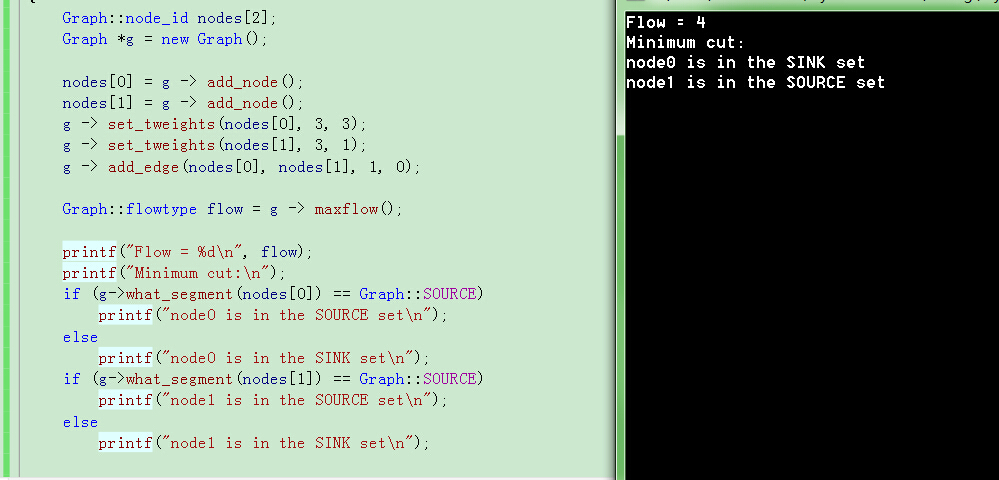图割论文大合集下载:
http://download.csdn.net/detail/wangyaninglm/8292305
代码:
/* graph.h */
/* Vladimir Kolmogorov (vnk@cs.cornell.edu), 2001. */
/*
This software library is a modification of the maxflow algorithm
described in
An Experimental Comparison of Min-Cut/Max-Flow Algorithms
for Energy Minimization in Computer Vision.
Yuri Boykov and Vladimir Kolmogorov.
In Third International Workshop on Energy Minimization
Methods in Computer Vision and Pattern Recognition, September 2001
This algorithm was originally developed at Siemens.
The main modification is that two trees are used for finding
augmenting paths - one grows from the source and the other
from the sink. (The original algorithm used only the former one).
Details will be described in my PhD thesis.
This implementation uses an adjacency list graph representation.邻接链表
Memory allocation:
Nodes: 22 bytes + one field to hold a residual capacity
of t-links (by default it is 'short' - 2 bytes)
Arcs: 12 bytes + one field to hold a residual capacity 剩余容量
(by default it is 'short' - 2 bytes)
(Note that arcs are always added in pairs (弧都是成对的添加)- in forward and reverse directions)
Example usage (computes a maxflow on the following graph):
SOURCE
/ \
1/ \2
/ 3 \
node0 -----> node1
| <----- |
| 4 |
\ /
5\ /6
\ /
SINK
///
#include <stdio.h>
#include "graph.h"
void test_maxflow()
{
Graph::node_id nodes[2];
Graph *g = new Graph();
nodes[0] = g -> add_node();
nodes[1] = g -> add_node();
g -> set_tweights(nodes[0], 1, 5);
g -> set_tweights(nodes[1], 2, 6);
g -> add_edge(nodes[0], nodes[1], 3, 4);
Graph::flowtype flow = g -> maxflow();
printf("Flow = %d\n", flow);
printf("Minimum cut:\n");
if (g->what_segment(nodes[0]) == Graph::SOURCE)
printf("node0 is in the SOURCE set\n");
else
printf("node0 is in the SINK set\n");
if (g->what_segment(nodes[1]) == Graph::SOURCE)
printf("node1 is in the SOURCE set\n");
else
printf("node1 is in the SINK set\n");
delete g;
}
///
*/
void test_maxflow()
{
Graph::node_id nodes[2];
Graph *g = new Graph();
nodes[0] = g -> add_node();
nodes[1] = g -> add_node();
g -> set_tweights(nodes[0], 3, 3);
g -> set_tweights(nodes[1], 3, 1);
g -> add_edge(nodes[0], nodes[1], 1, 0);
Graph::flowtype flow = g -> maxflow();
printf("Flow = %d\n", flow);
printf("Minimum cut:\n");
if (g->what_segment(nodes[0]) == Graph::SOURCE)
printf("node0 is in the SOURCE set\n");
else
printf("node0 is in the SINK set\n");
if (g->what_segment(nodes[1]) == Graph::SOURCE)
printf("node1 is in the SOURCE set\n");
else
printf("node1 is in the SINK set\n");
delete g;
}
这块主要就是要理解,什么是maxflow,以及节点最后分割的类型是SOURCE还是SINK分别意味着什么
graphcuts算法时间复杂度与其他最大流算法的比较:
添加几篇文章地址:
graphcuts资料博客大合集
http://vision.csd.uwo.ca/code/
http://lincccc.blogspot.tw/2011/04/graph-cut-and-its-application-in.html
http://blog.csdn.net/zouxy09/article/details/8532106
http://lincccc.blogspot.tw/2011/03/cuda-cuts-fast-graph-cuts-on-gpu_03.html
























 375
375











 被折叠的 条评论
为什么被折叠?
被折叠的 条评论
为什么被折叠?








